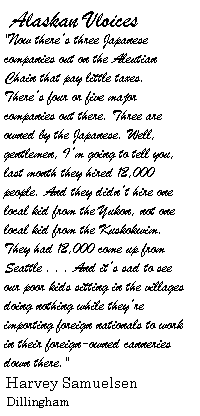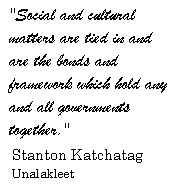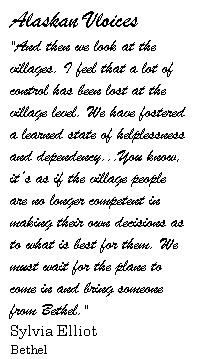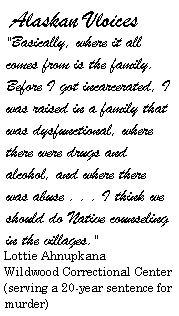Native
to
Native
If there is to be
any lasting improvement in the lives of Alaska
Natives living in villages, the problems of
unemployment and dependence on government
handouts for economic survival need to be
addressed and solved. The two go hand-in-hand.
Because of the high rate of unemployment —
well over 50 percent in most villages — many
Native families qualify for any number of
government assistance programs for which no work
is required.
As discussed in
other sections of this report, dependency has
become a major contributing factor in the
breakdown of Alaska Native society. It has broken
the healthy interdependence of families, tearing
at the social fabric that once held Native
communities together. It robs them of self-esteem
and feeds perceptions of poverty, inferiority,
helplessness, and uselessness. It compromises
Natives' natural sense of industriousness, and it
takes away any initiative to address and overcome
the many problems they face.
EMPLOYMENT
The acute and
chronic state of unemployment in the villages is
undermining the roles of village people. Alaska
Natives in the working-age population bear a
greater weight of what is called the "burden
of dependency" (the number of children and
elderly that must be provided for) than do
non-Natives. Yet many, if not most, of these some
working-age people do not have jobs, and they
have no likely prospects for jobs in the
foreseeable future.

This depressing
situation is most marked among younger Native
males, the very group that the Commission and
others have identified as being most at-risk for
developing behavioral health problems and
displaying social pathologies. These are the same
community members who, in earlier times, were
looked to for leadership, protection, and meeting
the basic survival needs of the tribe.

More and more,
village elders and. parents are saying that their
sons and grandsons need jobs. They need something
to do that is productive and contributes to the
well-being of the village and its children.
Taught as children in federal and state schools
that securing a job is an important measure of
success in life, young Natives find that there is
nowhere to turn in villages where jobs are
virtually non-existent.

Sometimes lacking
the education or training to compete for jobs in
other areas of the state, and often unwilling or
unable to leave their families and homes, many
Natives, particularly young men, are idle for
many months of the year. Depressed and
discouraged, they turn to alcohol and drugs to
relieve the tedium and feelings of uselessness,
hopelessness, and sense of failure. In time, as
the statistics show quite clearly, they become
alcohol abusers, victims of accidents, homicide,
and suicide. Many end up in prison for crimes
that are often committed under the influence of
alcohol.

Not all unemployed
young men become such statistics. But being a
significant part of a village's population, their
mental state, drinking, and idleness affect the
households in which they live and, by extension,
the emotional climate of the entire community.
Unable to support their own families, much less
build and maintain homes, they end up living with
parents or in-laws, adding further pressures to
everyday life.

Subsistence
hunting and fishing activities in which young
village men still participate no longer fill the
days and the months of the calendar as they once
did. And subsistence does not provide the income
needed to purchase other foods and consumer goods
that have become necessities in modern villages.
These young men, and many of their female
counterparts, are now dependents — reliant
on their parents who themselves must often look
to welfare programs for financial support. Hence,
the pleas coming from the fathers and mothers,
grandfathers and grandmothers: "Get jobs for
our young people." They know better than
anyone else what dependency and joblessness are
doing to their children and grandchildren. It is
tearing them apart. And it is tearing apart their
families and villages.
WELFARE
DEPENDENCY
Income maintenance
programs — or what are commonly referred to
as "welfare" programs — have
completed the breakdown of healthy village and
familial interdependence. In the place of this
social interdependence is an unhealthy dependence
on government to meet the basic survival needs of
tribal and family members. This goes hand-in-hand
with depending on federal and state governments
to make crucial decisions about how Natives’
needs can best be met.

There is no pride
in this way of living. In fact, a dependent way
of life intensifies the sense of helplessness and
lack of self-esteem that are seen so often among
Alaska Natives. In some cases, it appears as if
welfare programs have become an added addiction
and that they are symptomatic of all that is
wrong with life in Alaska Native villages.

Alaska Native
families and villages were traditionally close
knit, depending on one another for food and
shelter and, when needed, for caring. Family and
village members took care of each other; they
looked after each other. The health of one family
was of paramount importance to the others.
Families hunted together, camped together,
celebrated together. They were full together and
went hungry together. They shared each
other’s joys and each other’s sorrows.
So while they may have been "poor"
materially, they at least had each other. All too
often, this is not the case now. Government
anti-poverty programs have created a new poverty
... the poverty of the broken village family.

Families literally
do not need each other now that government has
stepped in to serve each member individually. The
result has been a drifting apart of families and
isolation of one from another. The large circle
of families, which was the traditional village,
is now a grouping of separate interests.

Many steps must be
taken to reverse this trend. One of the most
crucial steps is for family and community members
to begin seeing to the needs of one another. At
the same time, the village, as a social unit,
needs to assume decision-making capabilities and
authority regarding the circumstances of its
members and families.

Current income
maintenance and family assistance programs must
be restructured to meet a broader spectrum of
needs of Alaska Natives in areas beyond the
general scope of individual welfare. In time, the
programs should be dismantled.

In undertaking
this process, policymakers should have faith in
the capabilities of Alaska Natives. If given the
opportunity, they will feed themselves and their
children. They will not go unclothed. They will
find a way to clothe themselves and each other.
They will not freeze to death for lack of
housing. In the process, they will begin to
reclaim a sense of pride in who they are and what
they can achieve. They will rebuild a sense of
self-esteem and they will find purpose in life.

|
Recommendation
1. Increased local Native
employment opportunities, culturally appropriate
service delivery, and local decision-making and
management skills should be enhanced through
expanded contracting of government programs and
services to Native governments and other Native
providers in predominantly Native areas of the
state.
Discussion
The slow but steady evolution
toward a system of contracting government
services to institutions controlled by rural and
Native people is providing employment
opportunities once virtually inaccessible to many
people in rural Alaska. That system, though not
flawless, is also bolstering self-determination
efforts for Native people statewide by developing
the means for localized, grass-roots problem
solving and service delivery.
The State of Alaska should
enter into cooperative service delivery
agreements with Native organizations and
governments with clear procedures for contracting
to those institutions. As a matter of policy, the
State should contract with Native organizations
and governments where there is a proven
capability to manage programs and account for
program funds. State programs and initiatives
that impact the social and physical well-being of
Native individuals, families, and tribes in
village Alaska should be the primary initial
focus of what should become universal
contracting. These include, but are not limited
to, the following:. employment assistance, child
protective services, social and family services,
and alcohol and mental health programs.
With respect to federal funds
and contracting, the  Bureau of
Indian Affairs, the Indian Health Service, and
other federal agencies need to continue the
process of decentralizing and contracting
programs eligible for inclusion under P.L.
93-638, as amended. In this same light, regional
Native nonprofit associations and corporations
should move money, authority, and responsibility
to the villages. These institutions need to work
with tribal governments to review significant
shifts in programs and services from the regional
to the subregional and village level. Ultimately,
the local employment and tribal empowerment needs
in the villages should be balanced with the
realities of providing cost-effective, quality
services throughout rural Alaska. Bureau of
Indian Affairs, the Indian Health Service, and
other federal agencies need to continue the
process of decentralizing and contracting
programs eligible for inclusion under P.L.
93-638, as amended. In this same light, regional
Native nonprofit associations and corporations
should move money, authority, and responsibility
to the villages. These institutions need to work
with tribal governments to review significant
shifts in programs and services from the regional
to the subregional and village level. Ultimately,
the local employment and tribal empowerment needs
in the villages should be balanced with the
realities of providing cost-effective, quality
services throughout rural Alaska.
Given the superior record
Native organizations have in recruiting and
hiring Natives compared with the federal
government, the Alaska Natives Commission
recommends that Native organizations and
governments contract all federal functions
currently available for contracting under P.L.
93-638, as amended.
Recommendation
2. At a minimum, every federal
agency with programs eligible for contracting
under terms of P.L. 93-638, as amended, should
have a Native hire requirement similar to that
which is in place with the Indian Health Service,
and the Bureau of Indian Affairs; further, all
federal departments with job classifications
located in rural Alaska should be required to
maintain Native preference in hiring to ensure
that, at a minimum, the proportion of Native
employees corresponds to the proportion of
Natives in the population of the immediate area.
Discussion
The federal government employs
close to 20,000 people in Alaska. With two
exceptions — the Indian Health Service (IHS)
and the Bureau of Indian Affairs (BIA) — a
wide disparity exists between Alaska Natives as a
percentage of the state's population (16%) and
their representation in the federal work force
(5% not including the IHS and BIA). The key
factor distinguishing the IHS and the BIA from
other federal departments is a special
Congressionally approved Alaska Native hiring
preference. Federal agencies not under the terms
of the Native hire provision — which
includes most of the agencies operating in Alaska
seem unable to employ Alaska Natives in
meaningful numbers. Expanding Native hire
provisions to other agencies within the federal
system could result in substantial new job
opportunities of Alaska Natives.
The Commission was unable to
collect detailed figures pertaining to Alaska
Native hire in federal jobs located in
predominantly Native areas of the state. The
generally low percentage of Alaska Natives in the
federal work force in Alaska clearly indicates,
however, that the ratio of federal Native hires
in these areas is quite low, especially
considering the high percentage of Alaska Natives
in the rural population. For instance, in the
Alaska National Interest Lands Conservation Act
(ANILCA) passed in 1980, Congress directed the
Secretaries of the Interior and Agriculture to
institute Native and local preference in a number
of programs related to the Conservation System
Units established by the Act. None of these has
been followed even though the Conservation Units
are located in rural Alaska and most are in
proximity to predominantly Native communities.
Congress should revisit ANILCA with respect to
Native and local hire provisions and establish
legislative directives to the federal
administration for purposes of enforcing the
mandates of ANILCA. Oversight that can ensure
implementation of the mandates should be ongoing,
and should include representation from statewide,
regional, and local Native organizations and
corporations.
Recommendation
3. Limits to local Native
participation in capital improvement projects
— including hiring and wage rules that work
counter to local Naive employment needs —
must be overcome to ensure employment
opportunities for village residents in public
works planning, design, and construction in
villages.
Discussion
Most capital projects in
village Alaska are contracted to urban-based
companies, or to companies based  outside of Alaska. As is the case with
respect to so many aspects of Alaska Native
existence, local people become merely passive
recipients of the airports, roads, clinics, and
houses constructed for their benefit. The true
economic benefits of construction activities go
to businesses and to workers and their families
in Anchorage, Fairbanks, Seattle, and other
points south. More often than not, healthy young
Native people in the village literally watch from
their front doors as others from far away places
earn wages on projects intended to benefit
Natives. outside of Alaska. As is the case with
respect to so many aspects of Alaska Native
existence, local people become merely passive
recipients of the airports, roads, clinics, and
houses constructed for their benefit. The true
economic benefits of construction activities go
to businesses and to workers and their families
in Anchorage, Fairbanks, Seattle, and other
points south. More often than not, healthy young
Native people in the village literally watch from
their front doors as others from far away places
earn wages on projects intended to benefit
Natives.
The federal and state
governments should use force accounting on all
village capital projects to open opportunities
for local labor and talents in the planning,
design, and construction of these projects. Also,
the federal and state governments should apply
the federal Davis Bacon Act and the Alaska
"Mini-Davis Bacon" effectively and
rationally in conformity with the statutory rule
of the local prevailing wage.
The Alaska Natives Commission
has, in various reports, documented the projected
public works and housing needs that could lead to
significant future waves of capital expenditures
in rural Alaska. To the extent such expenditures
are forthcoming, every effort must be made to
ensure, that Native people are designing and
constructing the homes, putting in the sewer and
water systems that will service those homes,
building new community facilities, and repairing
and maintaining those already in place.
Recommendation
4. Limits to local Native
participation in rural Alaska resource production
and extraction industries must be clearly
identified and overcome to ensure employment
opportunities for village residents, expanded
economic benefits for rural economies, and
avenues for Native involvement generally.
Discussion
In general, the history of
resource development in Alaska resembles
colonialism at its finest: i.e. economic
"activity" consists largely of
extracting raw resources from Alaska's lands and
waters. In far too many cases, local Native
employment opportunities in the extraction phase
are marginal, as are secondary or tertiary
economic benefits to local economies.
A noteworthy exception is the
Community Development Quota (CDQ) program under
which. some 62 communities in western Alaska
share in-the royalties of the Bering Sea pollock
fisheries. The positive effects resulting from
the infusion of economic and social support and
assistance — including, local employment
opportunities created by the CDQs — are only
now beginning to be realized. There are
indications that the long-term rewards will have
a major impact on the coastal Native communities
in western Alaska. At the same time, the
Commission sees the potential for CDQ-type
approaches in other extraction industries, in
addition to fishing. What is of greatest
importance to policymakers is the need to look
more broadly at the full range of economic
development opportunities that might benefit
local Native communities in all future resource
development activities taking place in rural
Alaska.
Recommendation
5. Federal and State
regulations must be changed to allow for tribal
design and management of government income
support and maintenance programs, most notably:
Aid to Families with Dependent Children, Food
Stamps, State General Assistance, and the federal
General Assistance program funded under the
Bureau of Indian Affairs.
Discussion
What is . generally viewed as
-a social "safety net" in
contemporary-American life has become more of a
solid base from which many Alaska Natives now
live their lives. Historically, Alaska Natives
were a . people capable of meeting their own and
each other's needs through close familial and
communal sharing and support. systems. In modern
times, an ever-increasing number of Native
villages and families have become virtual
economic wards of the federal and state
governments. This is due mainly to the chronic
unemployment situation in much of village Alaska,
together with the loss of control of local
resources and local decision-making processes.
While financial assistance is
necessary until the rural areas of Alaska become
economically viable, there is a critical need to
restore pride and self-esteem to Alaska Natives
and a sense of community purpose to the villages.
Unless real changes are made to the current
system of income maintenance and financial
support programs in Native communities, the
overall well-being of Alaska Natives will
continue to deteriorate.
Recommendation
6. Utilizing government
transfer payment receipts, tribal governments in
Alaska should be permitted to design and
implement local "workfare" programs
that require productive, community
development-related employment where aid-eligible
households have at least one able-bodied,
employable member. Village workfare programs
should be designed to provide adequate training,
child care, and other support services for
participants.
Discussion
To the extent
"welfare" programs are restructured as  proposed in the foregoing discussion,
the potential benefits to working members of
households and their families are incalculable.
Not only would there be a restoration of pride
and self-esteem among individuals and families,
but workfare programs could be fashioned
to-benefit communities by providing needed labor
for, as examples, building and maintenance
projects and village planning and management. proposed in the foregoing discussion,
the potential benefits to working members of
households and their families are incalculable.
Not only would there be a restoration of pride
and self-esteem among individuals and families,
but workfare programs could be fashioned
to-benefit communities by providing needed labor
for, as examples, building and maintenance
projects and village planning and management.
There are any number of village
projects -toward which workfare funds can be
directed, many of them related to improving the
overall cleanliness and orderliness of
communities. Others relate to increasing the
ability of communities to manage and maintain
village infrastructure and improve local
government administration. The money can also be
used to augment educational and health service
programs.
By offering a viable and
honorable interim solution to the need for
meaningful employment in village Alaska, such a
move by government would complement various
prevention, education, and village healing
efforts proposed in other sections of this
report.
|

 against self and others,
disregard for roles as family and tribal members, and alcohol abuse.
against self and others,
disregard for roles as family and tribal members, and alcohol abuse. In the long run,
financial savings for governments will likely be realized
in proportion to the decrease in need for government,
social, and behavioral health programs. As it is,
governments spend hundreds of millions of dollars each
year on emergency health care, public safety,
corrections, and social services for Alaska Natives. Over
time, healthier communities should ultimately translate
into significant savings to the public.
In the long run,
financial savings for governments will likely be realized
in proportion to the decrease in need for government,
social, and behavioral health programs. As it is,
governments spend hundreds of millions of dollars each
year on emergency health care, public safety,
corrections, and social services for Alaska Natives. Over
time, healthier communities should ultimately translate
into significant savings to the public. Bureau of
Indian Affairs, the Indian Health Service, and
other federal agencies need to continue the
process of decentralizing and contracting
programs eligible for inclusion under P.L.
93-638, as amended. In this same light, regional
Native nonprofit associations and corporations
should move money, authority, and responsibility
to the villages. These institutions need to work
with tribal governments to review significant
shifts in programs and services from the regional
to the subregional and village level. Ultimately,
the local employment and tribal empowerment needs
in the villages should be balanced with the
realities of providing cost-effective, quality
services throughout rural Alaska.
Bureau of
Indian Affairs, the Indian Health Service, and
other federal agencies need to continue the
process of decentralizing and contracting
programs eligible for inclusion under P.L.
93-638, as amended. In this same light, regional
Native nonprofit associations and corporations
should move money, authority, and responsibility
to the villages. These institutions need to work
with tribal governments to review significant
shifts in programs and services from the regional
to the subregional and village level. Ultimately,
the local employment and tribal empowerment needs
in the villages should be balanced with the
realities of providing cost-effective, quality
services throughout rural Alaska. outside of Alaska. As is the case with
respect to so many aspects of Alaska Native
existence, local people become merely passive
recipients of the airports, roads, clinics, and
houses constructed for their benefit. The true
economic benefits of construction activities go
to businesses and to workers and their families
in Anchorage, Fairbanks, Seattle, and other
points south. More often than not, healthy young
Native people in the village literally watch from
their front doors as others from far away places
earn wages on projects intended to benefit
Natives.
outside of Alaska. As is the case with
respect to so many aspects of Alaska Native
existence, local people become merely passive
recipients of the airports, roads, clinics, and
houses constructed for their benefit. The true
economic benefits of construction activities go
to businesses and to workers and their families
in Anchorage, Fairbanks, Seattle, and other
points south. More often than not, healthy young
Native people in the village literally watch from
their front doors as others from far away places
earn wages on projects intended to benefit
Natives. proposed in the foregoing discussion,
the potential benefits to working members of
households and their families are incalculable.
Not only would there be a restoration of pride
and self-esteem among individuals and families,
but workfare programs could be fashioned
to-benefit communities by providing needed labor
for, as examples, building and maintenance
projects and village planning and management.
proposed in the foregoing discussion,
the potential benefits to working members of
households and their families are incalculable.
Not only would there be a restoration of pride
and self-esteem among individuals and families,
but workfare programs could be fashioned
to-benefit communities by providing needed labor
for, as examples, building and maintenance
projects and village planning and management.